Are you planning a site migration for your company’s online presence? You might be looking to change your domain name, or move to a different CMS, or making some structural changes to how your website is accessed. In any case, a site migration is a challenging project an ecommerce website owner will ever take on, as they can have a significant impact on the site’s performance and visibility.
The costs of a poorly planned site migration can be catastrophic, leading to a collapse in organic traffic and revenue. So, making sure your site migration is well planned and executed is, of course, vital.
In this blog post, you’ll learn more about SEO website site migrations – and some of the key risks to watch out for.
- What is an SEO site migration?
- Why site migrations fail
- Key risks of a site migration
- Revenue impact of site migrations
What is an SEO site migration?
In terms of SEO, a site migration refers to a planned activity where a website goes through a change or series of changes over a planned period of time, which impact the way the website interacts with the users and ultimately search engines. An SEO site migration often involves one or more of the following:
Site location/address changes:
Domain changes (e.g. rebranding/changing address to a new domain name )
For instance, TransferWise.com migrated to Wise.com in March 2021, which in the short term saw a decline and took over 8 months to reach the legacy site’s visibility. But visibility has since grown to 3.5x the legacy site’s visibility, making it a successful site migration story over a longer period.
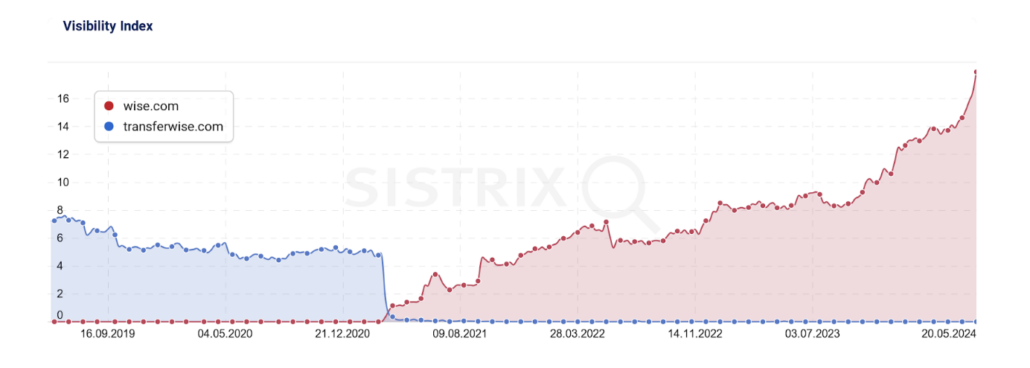
In another example, WooCommerce decided to migrate their website in November 2023 to a very valuable three letters domain – Woo.com. However, not only did they see a more than 90% immediate drop in their organic visibility , they never quite recovered – and saw a huge impact on their traffic. As a result, five months after the migration, they reverted the site back to WooCommerce.com, which took them back to pre-migration visibility levels.
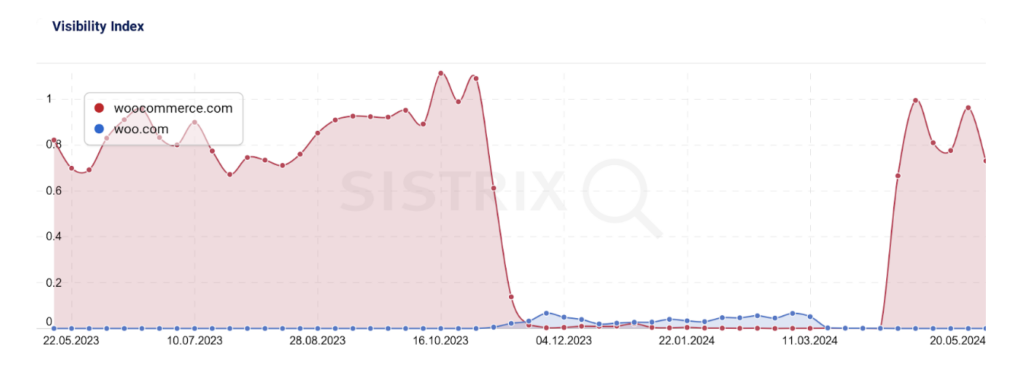
Switching from a gTLD to ccTLDs or vice versa. (e.g. launching country specific domains for an existing sub-directory in the gTLD)
For example, Skechers moved from their global domain with a UK sub-directory skechers.com/en-gb/ to a UK ccTLD skechers.co.uk/
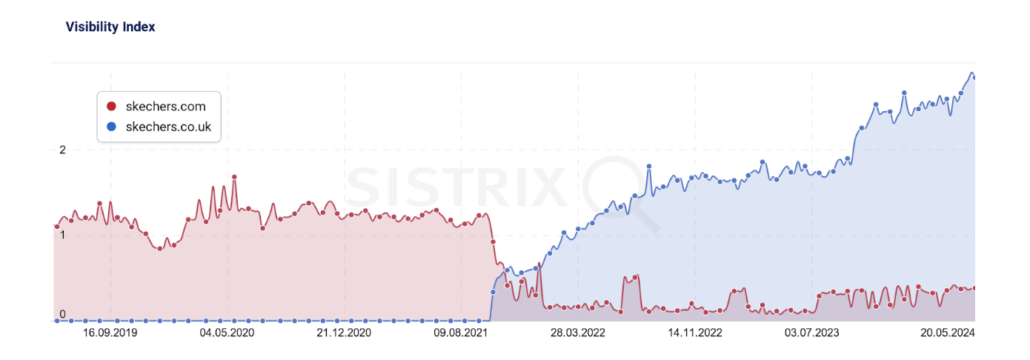
Alternatively, ASICS did the opposite and consolidated their ccTLDs into one global domain with each country having its own sub-directory
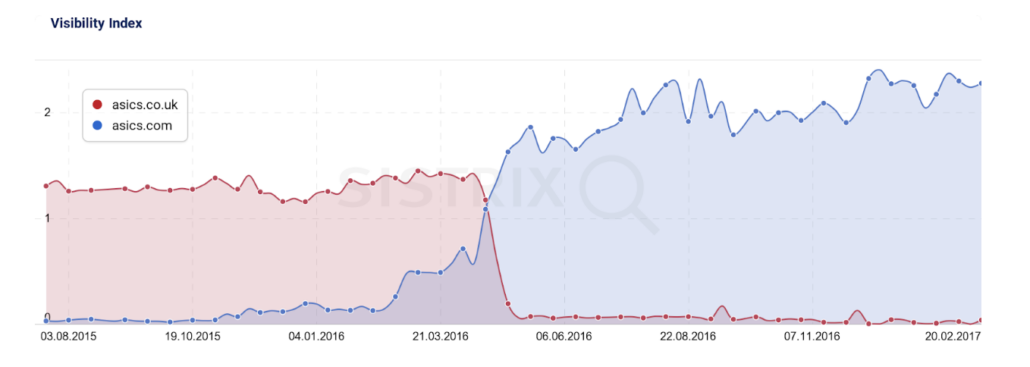
Merging or consolidating websites (e.g. moving an existing site to a new site’s folder/url permanently)
A good example is Next PLC’s acquisition of https://www.cathkidston.com/ which saw its inventory move to https://www.next.co.uk/cath-kidston , similar to all its other acquisitions]
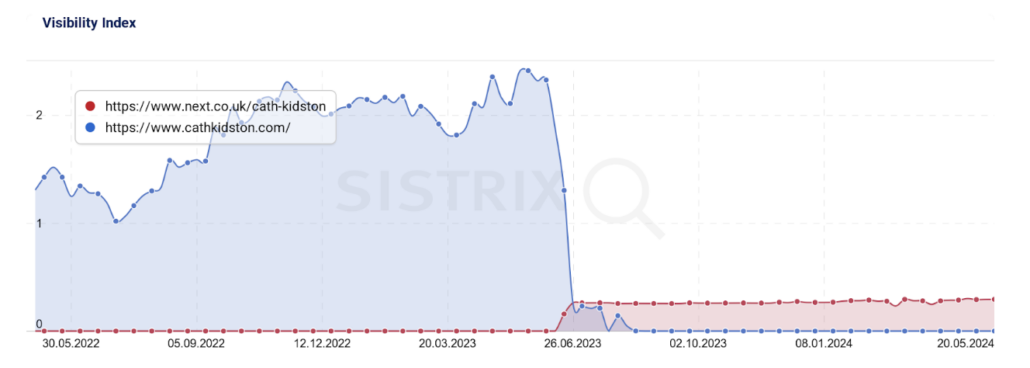
Protocol changes (e.g. changing from an HTTP to HTTPS protocol, which means the address to site is now different starting from “https://” instead of “http://” )
Structural changes (e.g. This is more likely to involve, reorganising the site’s information architecture or structural hierarchy, or changes to navigation and mega-menus to overhauling user journeys with URL changes )
Platform/CMS Changes:
- Moving to a new CMS (e.g. from WordPress to Storyblok, Shopify to SFCC, Magento to WooCommerce etc.)
- Changing elements of the codebase (e.g. moving SFRA (Storefront Reference Architecture) deployment to Vercel from SFCC (Salesforce Commerce Cloud))
- Integrating multiple platforms to work together
- Upgrading or building new features
Content changes:
- Content migration (adding, removing, or consolidating pages) from external or internal sources
- Introducing localised content in multiple languages/locales
UX / Design changes:
- Redesigning the website’s appearance, interactivity and user experience
- Changes that impact speed, core web vitals, load and response times
- Enhancing adaptability and responsiveness
- Rich-media content (e.g. videos, interactive elements) being served differently
Why site migrations fail
Irrespective of the site migration type, there are several common site migration pitfalls. Here are some of the key reasons why some site migrations are not so successful:
- Proposing a migration without clear objectives/strategy
- Not allowing sufficient time for planning and preparation
- Lacking the right resources/budget for implementation or slow response to bug fixes when identified
- Involving SEO team very late or often post-migration
- Not being thorough with QA testing at Staging/Development stages
- No collaboration amongst SEOs and other stakeholders in Product, UX, Paid Search or Analytics etc.
- Overlooking mobile, analytics tracking and fundamentals like robots.txt and XML sitemaps
- Going live without fully implementing the proposed recommendations
- Underestimating the scale of project and its impact
Key risks of a site migration:
If you are considering a site migration for your ecommerce store, it’s important to be aware of the key risks involved.
The outcomes of a site migration are dependent on the manner in which it was carried out. On one hand, a seamless site migration can not only retain the organic equity and visibility of the legacy site, but also pave the way for more generic growth at scale due to forward-thinking and careful planning. On the other hand, if the site migration was poorly planned and executed, the implications can be significant from a revenue standpoint.
A botched site migration can have significant impact on an ecommerce business, particularly where the site is directly involved in generating revenue via sales, conversions etc. This is especially significant for organic search, where the main source of inbound traffic are search engines that have not been assisted to understand the site’s move and are now unable to guide users to your sites for relevant queries.
Some key site migration risks include:
Organic search visibility decline: One of the biggest risks associated with site migrations is a sudden drop in organic search visibility and rankings, mainly due to faulty/or no redirects, technical SEO issues like broken links, blocked resources, rendering or content duplicates etc. This not only limits your organic market share in search results, but the loss of rankings across a wider range of searches leads to a corresponding decline in organic search traffic – which of course represents a major source of sales and revenue for most ecommerce sites.
This lost traffic represents a major revenue hit as the downward trend can last for months if the issues are not resolved on time, and even then can take more time to get back on an upward trajectory.This not only limits your organic market share in search results, but the loss of rankings across a wider range of searches leads to a corresponding decline in organic search traffic – which of course represents a major source of sales and revenue for most ecommerce sites. This lost traffic represents a major revenue hit as the downward trend can last for months if the issues are not resolved on time, and even then can take more time to get back on an upward trajectory.
Requiring additional marketing spend to make up the loss: Brands may have to increase their paid search or ad spend – often drastically – to be able to make up for the loss in organic traffic, which wouldn’t have been a problem in a well planned site migration. In a competitive industry, even this temporary paid traffic can be extremely costly, adding more dents to profitability.
Interruption to analytics and performance campaigns tracking: Compounding the problem, a site migration may also disrupt tracking and analytics data, leaving the business temporarily blind to key insights and performance metrics. This, on top of declining organic traffic (verifiable with GSC and third party tools) and lack of data makes diagnosing and fixing the underlying problems even more challenging.
Accumulation of technical debt: In case of a rushed or poorly executed site migration, businesses may incur significant costs for dev time and resources to fix technical issues that then have a tendency to compound the longer these issues exist. This adds more work to an already overburdened development pipeline which can further delay any priority technical tickets that need timely fixes.
Poor User Experience directly impacting conversion rate and sales: If there was limited to no alignment across SEO and UX at the planning and pre-launch stages, you’re bound to have a site migration rollout that is now faced with poor user experience, either from broken pages, slow load times, or missing content/product grids etc. This can directly cause a drop to conversion rates and sales/revenue until the UX issues are diagnosed and fixed.
Site migration revenue impact
While the exact financial impact depends on the specifics, nature and the scale of the migration, the potential cost of a mismanaged ecommerce site migration can be extremely high. This is because, apart from the risks outlined above, the wider scale of the impact extends beyond organic search alone. A site migration also affects things like:
- Brand reputation and trust: Apart from getting called out over social media, on review sites like TrustPilot, or forums like Reddit where users can share their frustrations about brands, a problematic migration resulting in a poor experience can undermine brand reputation and consumer trust. Rebuilding that trust and brand equity is an intangible but real cost.
- Operational and logistical implications: Performance impacts after site migrations can affect not only marketing but also other critical business functions such as failure to clear excess or old stocks, disruptions in inventory management, order fulfilment, and customer service.
- Opportunity costs of delayed launches/initiatives: Finally, the time and resources required to resolve problems stemming from a botched migration can delay other initiatives in the pipeline and potential launch of new product/features or even market expansion, incurring wider opportunity costs to the business.
A failed migration can set an ecommerce business back months – if not years – in terms of online visibility, brand reputation, and revenue until the SEO problems are identified and resolved. Fundamentally, ecommerce brands can’t afford to get it wrong.
However, the benefits of a successful migration, can have lasting positive effects. Recently, We carried out a Salesforce Commerce Cloud (SFCC) migration of a Re:signal client’ site from their EU based locale on their european domain (.eu/en-pl/) to their new ccTLD (.pl/en-pl/) shipped in time for Black Friday/Cyber Monday period. This involved a full domain/URL change, ALIAS configuration, redirections, hreflangs checks, content rendering checks, internal link checks, sitemap creation & validation as well as post-launch support and more.
The goal was to ensure performance remained consistent, and that clicks and revenue didn’t see significant drops, allowing us a platform to launch a localised version of the site following this move.
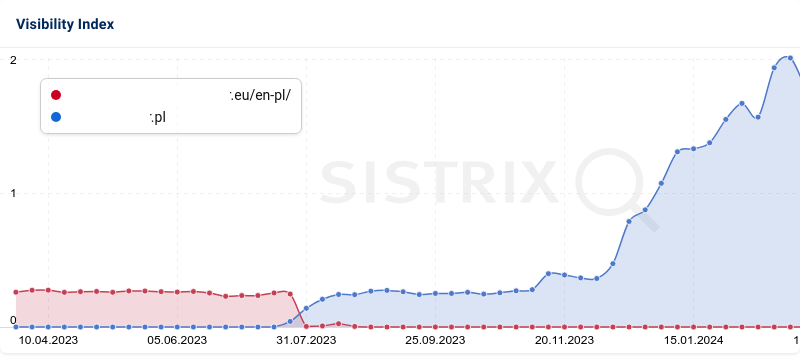
As demonstrated, the EN site saw a flawless migration with visibility intact all the way through to Black Friday/Cyber Monday, following which, 2 weeks later we launched the localised PL site on top of the existing, and the visibility has been growing since.
Are you considering a site migration? Re:signal can help. Our highly experienced team has delivered dozens of complex site migrations for national and international ecommerce brands. Contact us today about your ecommerce site migration.



